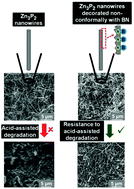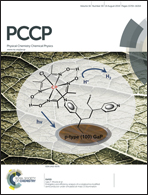Non-conformal decoration of semiconductor nanowire surfaces with boron nitride (BN) molecules for stability enhancement: degradation-resistant Zn3P2, ZnO and Mg2Si nanowires†
Abstract
A simple and reliable strategy for stabilizing the surfaces of compound semiconductors was presented. The strategy involved decorating the surfaces of compound semiconductor nanowires non-conformally with small molecules of boron nitride (BN). More specifically, Zn3P2, ZnO and Mg2Si nanowires, highly useful in energy conversion device fabrication (e.g., photovoltaics and thermoelectrics), have been stabilized against air- and acid-assisted degradation by decorating their surfaces with small molecules of BN. It is believed that the decoration of the nanowire surfaces with BN molecules made the nanowire surfaces non-wettable to water and aqueous acid solutions, and thereby imparted them enhanced resistance against water- and acid-assisted degradation. This procedure did not alter the bandgap of the nanowires. Moreover, this procedure aided in retaining the electrical conduction between the nanowire interfaces when the nanowires are assembled into mats or pellets. This strategy solves one of the primary bottlenecks in the widespread use of nanowires in energy conversion device fabrication, namely their stability. It is believed that this strategy is applicable for stabilizing other compound semiconductor nanowires, including nitrides, sulfides, silicides and antimonides.


 Please wait while we load your content...
Please wait while we load your content...